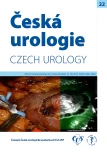The impact of changing antimuscarinics on quality of live in patients with overactive bladder – results of the VEST trial
Authors:
Lukáš Holub; Petr Hušek; Josef Košina; Jaroslav Pacovský; Miloš Bro? Ák
Authors‘ workplace:
Urologická klinika LF a FN Hradec Králové
Published in:
Ces Urol 2018; 22(2): 106-114
Category:
Original Articles
Overview
Primary Objective:
The authors present the results of a multicentre, noninterventional, prospective, one-arm, observational study into the effect of solifenacin on the quality of life versus previous antimuscarinic treatment. Method: Satisfaction with treatment was measured by Perception of Treatment Satisfaction (TSVAS), Over Active Bladder-q Short Form (OAB-q SF) and EuroQol Group scoring system (EQ-5D-5L)
Results:
A representative sample of the OAB population was evaluated in the study (2000 patients included in 60 centers in the Czech Republic, 1481 patients completed all 5 evaluations and 1,892 patients had baseline and at least 1 post-treatment). Improvements in QoL and OAB symptoms were observed over a period of 12 months in the population of patients treated with solifenacin 5–10 mg and previously treated with other antimuscarinic agents. OAB-q SF scores, including Total HRQoL Score, all HRQoL subscores and Symptom Severity Score, all improved over the study period. Changes in TS-VAS scores also demonstrated improvements in overall QoL over the study period. The EQ-5D-5L showed shifts towards improved QoL for all dimensions. Data from 3-day bladder diaries demonstrated improvements in OAB symptoms over the course of the study, including frequency, urgency, nocturia and incontinence. Solifenacin was well tolerated in the current study with only 15 non-serious, mild adverse events reported, mainly dry mouth (n=12). Solifenacin did not have any notable effect on post-void residual volume, risk of urinary retention or any effect on urinary flow rate. Conclusion: The study shows statistical improvements in all parameters evaluated. According to the results, solifenacin is a suitable drug for patients who fail treatment with other antimuscarinics.
KEY WORDS
Antimuscarinics, overactive bladder, solifenacin.
Sources
1. Abrams P, Kelleher CJ, Kerr LA, Rogers RG. Overactive bladder significantly affects quality of life. Am J Manag Care. 2000; 6 (11 Suppl): S580–590.
2. Coyne KS, Matza LS, Thompson CL, Kopp ZS, Khullar V. Determining the importance of change in the overactive bladder questionnaire. J Urol. 2006; 176(2): 627–632.
3. Irwin DE, Milsom I, Hunskaar S, et al. Population‑based survey of urinary incontinence, overactive bladder, and other lower urinary tract symptoms in five countries: results of the EPIC study. Eur Urol. 2006; 50(6): 1306–1314.
4. Abrams P, Artibani W, Cardozo L, et al. Reviewing the ICS 2002 terminology report: the ongoing debate. Neurourol Urodyn. 2006; 25(3): 293.
5. Abrams P, Cardozo L, Fall M, et al. The standardisation of terminology of lower urinary tract function: report from the Standardisation Sub‑committee of the International Continence Society. Neurourol Urodyn. 2002; 21(2): 167–178.
6. Wagg A. Persistence with medication and overactive bladder: an ongoing challenge. Expert Rev Pharmacoecon Outcomes Res. 2016; 16(4): 475–481.
7. Chancellor MB, Zinner N, Whitmore K, et al. Efficacy of solifenacin in patients previously treated with tolterodine extended release 4 mg: results of a 12-week, multicenter, open‑label, flexible‑dose study. Clin Ther. 2008; 30(10): 1766–1781.
8. Chapple CR. Solifenacin provides effective antimuscarinic therapy for the complete management of overactive bladder. Expert Opin Pharmacother. 2006; 7(17): 2421–2434.
9. Robinson D, Cardozo L. Solifenacin: pharmacology and clinical efficacy. Expert Rev Clin Pharmacol. 2009; 2(3): 239–253.
10. Chancellor MB, Yehoshua A, Waweru C, et al. Limitations of anticholinergic cycling in patients with overactive bladder (OAB) with urinary incontinence (UI): results from the CONsequences of Treatment Refractory Overactive bLadder (CONTROL) study. Int Urol Nephrol. 2016; 48(7): 1029–1036.
11. Desroziers K, Aballéa S, Maman K, et al. Estimating EQ-5D and OAB-5D health state utilities for patients with overactive bladder. Health Qual Life Outcomes. 2013; 11 : 200.
12. Irwin DE, Kopp ZS, Agatep B, Milsom I, Abrams P. Worldwide prevalence estimates of lower urinary tract symptoms, overactive bladder, urinary incontinence and bladder outlet obstruction. BJU Int. 2011; 108(7): 1132–1138.
13. Pavesi M, Devlin N, Hakimi Z, et al. Understanding the effects on HR‑QoL of treatment for overactive bladder: a detailed analysis of EQ-5D clinical trial data for mirabegron. J Med Econ. 2013; 16(7): 866–876.
14. Coyne KS, Wein AJ, Tubaro A, et al. The burden of lower urinary tract symptoms: evaluating the effect of LUTS on health‑related quality of life, anxiety and depression: EpiLUTS. BJU Int. 2009; 103(Suppl 3): 4–11.
Labels
Paediatric urologist Nephrology UrologyArticle was published in
Czech Urology

2018 Issue 2
Most read in this issue
- Mondor’s penile disease – our results
- MRI ultrasound fusion biopsy in the diagnosis of prostate cancer
- Usage of indocyanine green in urological robotic surgery
- A rare case of eosinophilic funiculitis
